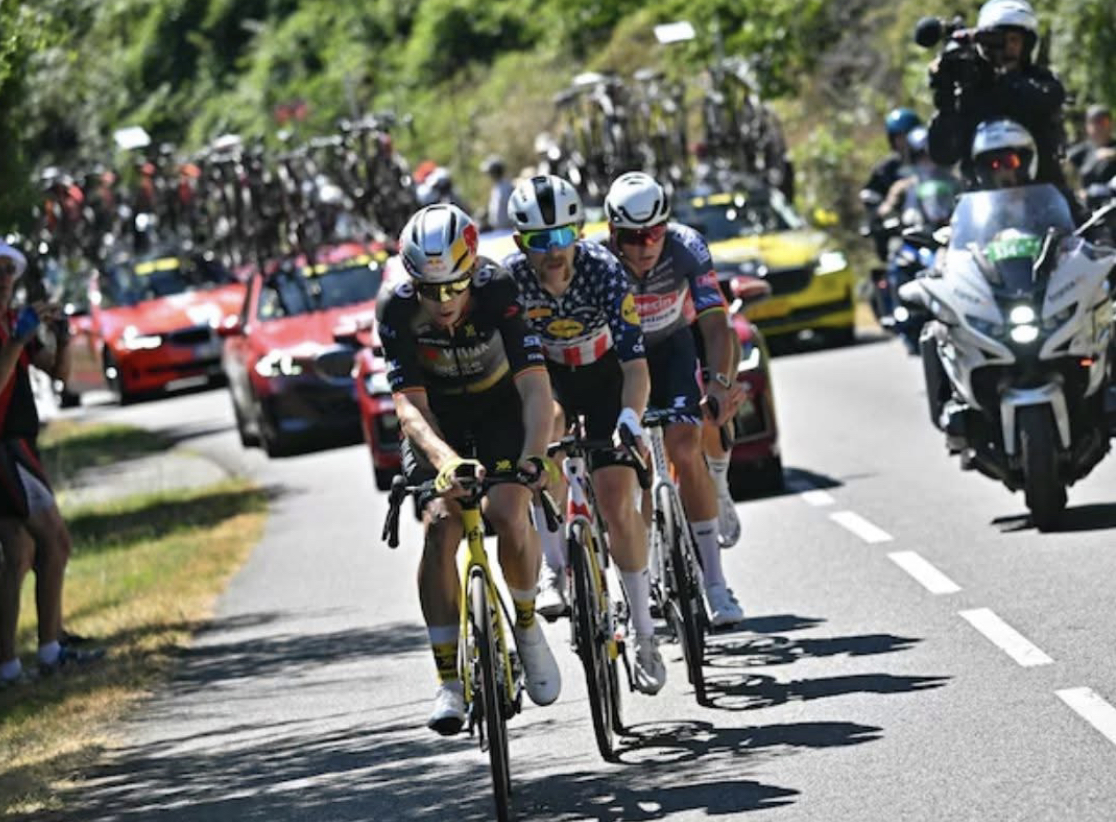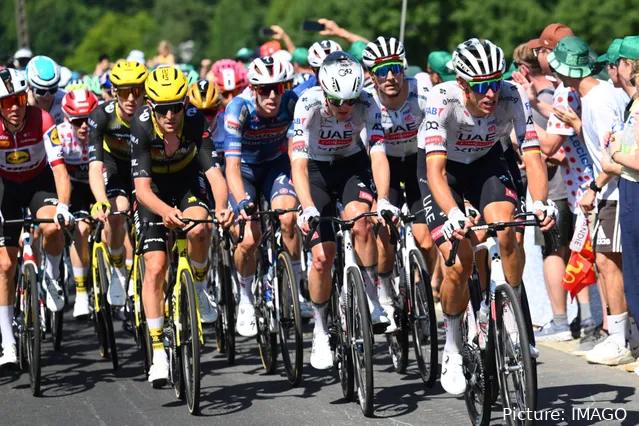**Not Having Your Period Isn’t Normal: Cedrine Kerbaol Offers Stark Warning to Tour de France Femmes Peloton Amid Growing Health Concerns**
In recent years, the conversation surrounding women’s health in professional sports has gained significant traction, revealing critical issues that often go unnoticed or unaddressed. Among these concerns is the alarming trend of female athletes experiencing menstrual disturbances, including amenorrhea—the absence of menstruation—which can be a harbinger of serious health problems. Cedrine Kerbaol, a prominent figure in professional cycling and an outspoken advocate for athlete well-being, has recently issued a stark warning to the peloton of the Tour de France Femmes: *”Before we’re athletes, we’re women.”* Her message underscores the importance of recognizing and respecting women’s health needs within the high-pressure environment of elite sports.
This article delves into the multifaceted issue of menstrual health among female athletes, exploring why the absence of periods is not a normal or acceptable condition, the underlying causes, the potential health consequences, and what sports organizations, coaches, and athletes can do to foster a healthier, more sustainable sporting culture.
The Reality of Menstrual Health in Female Athletes
Menstruation is a natural biological process that signifies reproductive health. For most women, it occurs on a regular cycle, typically every 21 to 35 days. However, in the world of elite sports, many female athletes report irregular cycles or complete absence of menstruation. This phenomenon, often termed *exercise-induced amenorrhea*, has become increasingly prevalent, especially in endurance sports such as cycling, running, and triathlon.
**Cedrine Kerbaol’s Message**
Kerbaol’s comments at the Tour de France Femmes highlight a crucial truth: neglecting menstrual health can have dire consequences. Her warning is rooted in her own experiences and observations within the peloton. She emphasizes that athletes, despite their physical prowess, are still women—biological beings with specific health needs that must be prioritized.
Why Is the Absence of Periods Not Normal?
While some may mistakenly perceive amenorrhea as a sign of elite fitness or a desirable trait in endurance sports (due to reduced weight or perceived performance benefits), medical science unequivocally states otherwise. The absence of menstruation is a clinical sign of underlying health issues, often linked to energy deficiency, nutritional deficits, or hormonal imbalances.
– **Hormonal Imbalance:** Menstruation is regulated by a complex interplay of hormones, primarily estrogen and progesterone. Disruption in these hormones can lead to amenorrhea.
– **Indicator of Energy Deficit:** Persistent absence of periods often indicates inadequate caloric intake relative to energy expenditure—a condition known as *Relative Energy Deficiency in Sport (RED-S)*.
– **Potential for Long-term Health Risks:** Amenorrhea can lead to decreased bone mineral density, increasing the risk of osteoporosis and fractures later in life.
The Underlying Causes of Menstrual Disruptions in Female Athletes
Several factors contribute to menstrual irregularities among athletes, with the most significant being *disordered eating*, *excessive training*, and *psychological stress*. These elements often coexist and exacerbate each other.
At the core of many menstrual issues is a state of energy deficiency—when caloric intake falls short of energy expenditure, especially in high-intensity training. This imbalance disrupts hormonal production, especially of gonadotropin-releasing hormone (GnRH), which governs menstrual cycles.
Inadequate nutrition, restrictive dieting, or insufficient intake of vital nutrients like calcium, vitamin D, and healthy fats can impair hormonal health and bone density.
The mental and emotional stress of competition, expectations, and body image concerns can influence hormonal functioning, further contributing to menstrual irregularities
Excessive training without sufficient recovery can elevate cortisol levels (stress hormone), which interferes with reproductive hormones.
Health Consequences of Amenorrhea and RED-S
The implications of persistent menstrual disruptions extend beyond reproductive health, impacting overall well-being and athletic performance.
Estrogen plays a crucial role in maintaining bone density. Its deficiency, as seen in amenorrhea, can lead to osteoporosis, increasing fracture risk.
Hormonal imbalances can affect lipid profiles and cardiovascular function, posing long-term health risks.
Prolonged amenorrhea can impair fertility and reproductive function later in life.
Hormonal disturbances may contribute to mood disorders, anxiety, and decreased motivation.
Ironically, health issues stemming from amenorrhea can diminish endurance, strength, and overall performance, counteracting the athlete’s goals.
Despite the clear health risks, the culture within some sports environments inadvertently promotes or tolerates unhealthy behaviors:
– **Emphasis on Low Body Weight**: The obsession with weight and aesthetics, especially in sports like cycling, can lead athletes to restrict caloric intake.
– **Performance Over Health**: The pressure to perform can cause athletes to ignore or dismiss symptoms of health issues.
– **Lack of Education and Awareness**: Coaches, trainers, and athletes may lack adequate knowledge about menstrual health and RED-S.
Kerbaol’s warning is a rallying cry to all stakeholders in women’s sports: prioritize health over performance, recognize that women are not just athletes but women with biological needs, and establish systems that support sustainable, healthy training practices.
Her message underscores several key points:
– **Open Conversations**: Encourage dialogue about menstrual health without stigma.
– **Education and Awareness**: Implement comprehensive education programs for athletes and coaches.
– **Medical Support**: Ensure regular health check-ups and access to specialized medical professionals.
– **Cultural Shift**: Promote a sporting environment that values health, well-being, and longevity over short-term performance gains.
Athletes should have routine screenings that include menstrual health assessments, bone density scans, and hormonal evaluations.
Dietitians specializing in sports nutrition can help athletes develop balanced meal plans that meet energy needs.
Incorporate adequate recovery periods into training schedules to prevent overtraining and stress-related health issues.
Disseminate information on RED-S, menstrual health, and the importance of listening to one’s body.
Sports organizations should develop policies that recognize menstrual health as a critical aspect of athlete welfare.
Cedrine Kerbaol’s candid warning is a vital reminder that women’s health must be at the forefront of athletic pursuits. The narrative should shift from viewing menstrual irregularities as a badge of endurance or resilience to recognizing them as warning signs demanding attention and intervention.
“Before we’re athletes, we’re women,”** Kerbaol emphasizes. The message is clear: respecting and caring for women’s health is fundamental to fostering a sustainable, ethical, and inclusive sporting landscape. Addressing menstrual health issues not only safeguards the well-being of individual athletes but also upholds the integrity and future of women’s sports.
The growing awareness around menstrual health and RED-S in professional sports marks a positive step forward. Athletes like Cedrine Kerbaol lead by example, advocating for a culture that values health equally with performance. By embracing education, open dialogue, and proactive health management, the sporting community can ensure that women athletes thrive—not just on the podium but in their overall well-being and long-term health


